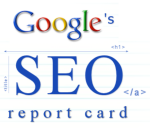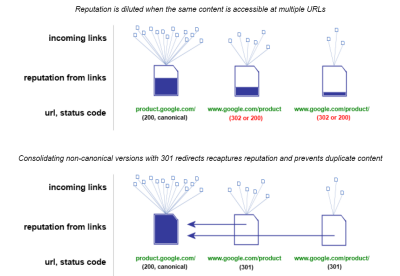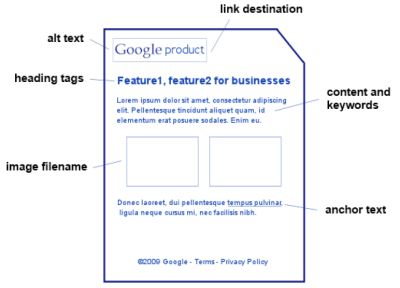Google Releases Best SEO Tips Ever
Google Releases Best SEO Tips Ever

Best SEO Tips by Google is as of this date still valid and relevant to the subject matter. While there may have been some “small changes”, this SEO Report card covers pretty much what you need to know to get things started. To further help you with your Search Engine Optimization, get familiar with the updated features of Google’s Webmaster Tools and more recently, Matt Cutt’s reply to a query that was made on webmaster central about Social sites being included in their ranking factors.
When Google releases something that relates to SEO, I very quickly see what the fuzz is all about. The most recent information about SEO from Google is their SEO report card which they have made public. I have read this report thoroughly and I highly recommend for anyone to read it, regardless of what level of experience you have.
What’s In The Google SEO Report Card
First, let us understand what the Google Report Card is. Over to you Google (read carefully):
Google’s SEO Report Card is an effort to provide Google’s product teams with ideas on how they can improve their products’ pages using simple and accepted optimizations. These optimizations are intended to not only help search engines understand the content of our pages better, but also to improve our users’ experience when visiting our sites. Simple steps such as fixing 404s and broken links, simplifying URL choice, and providing easier-to-understand titles and snippets for our pages can benefit both users and search engines. From the start of the project we also wanted to release the report card publicly so other companies and webmasters could learn from the report, which is filled with dozens of examples taken straight from our products’ pages.
For short, the report card is the result of an almost self-audit which the Google team performed to analyzed their own pages and how they are performing on search engines. If you decide to read this report, please pay particular attention to not only the important SEO factors, but also the recommendations. These recommendations are by far what you should be focusing in while doing your SEO.
The full report has 49 pages of reading material. Before sending you there, I want to share with you some of the most interesting topics that I have found while reading this report. The report is divided into three main topics or subjects:
Best SEO Practices
Subject I: Search result presentation
Optimizing a page’s title tag, description meta tag, and the structure of your URL can seriously help in improving the presentation of your pages in the search results. This helps users make more informed decisions about the results they click on and at the same time improving your CTR (click through rate).
Optimizing a page’s title tag, description meta tag, and the structure of your URL can seriously help in improving the presentation of your pages in the search results. This helps users make more informed decisions about the results they click on and at the same time improving your CTR (click through rate).
And as per the report:
A more descriptive title tag (optimized keywords) and URL naming structure can help the search engine understand the content of the pagebetter. It is suggested to use a maximum of 60 characters on title tags as an opportunity to tell both users and search engines what the focus of the page is. There’s no need to go past this many characters, as most search engines will display ellipses ( … ) after this limit. Also, search engines may give less weight to words after a certain point.
 Note that meta keyword tag is missing – no longer important but would not hurt if you use it, after all, there are more than one search engine. In addition, look at the bold caption above and you will see (hopefully) that SEO is about search engines understanding what your page is about before anything else.
Note that meta keyword tag is missing – no longer important but would not hurt if you use it, after all, there are more than one search engine. In addition, look at the bold caption above and you will see (hopefully) that SEO is about search engines understanding what your page is about before anything else.Subject II: URLs and redirects
URLs can take many different forms. With so many different forms of URLs, users face a daunting task knowing which URL format to use. Such varied URL behavior can lead to 404 pages and split reputation between multiple URLs, hurting the ranking of content.
URLs can take many different forms. With so many different forms of URLs, users face a daunting task knowing which URL format to use. Such varied URL behavior can lead to 404 pages and split reputation between multiple URLs, hurting the ranking of content.
Here are the top recommendations to help you with this:
• choose the easiest to remember form of the URL as the canonical
• be consistent with this canonical form across all products
• think of the most common URL forms visitors may try and 301 redirect these to the preferred/
canonical URL or use the rel=”canonical” link element if you cannot redirect
• choose the easiest to remember form of the URL as the canonical
• be consistent with this canonical form across all products
• think of the most common URL forms visitors may try and 301 redirect these to the preferred/
canonical URL or use the rel=”canonical” link element if you cannot redirect
 Subject III: On-page optimizations
Subject III: On-page optimizationsThe most important part of this report, in my opinion. You can even skip the second section for a while and jump directly to this part. If you still have the will, then scan through the section of URLs and redirects.
Optimizing on-page elements of your pages, such as keywords, heading tags, and internal links can help search engines better understand the content of these pages and how they’re structured. Also, many of these optimizations aid users’ navigation and usability of the site. On-page optimization is totally under your control so it really depends only on you to make it happen. Take a peek at the following elements where you have full control:
 As you can see, there are hints and suggestions to learn from Google’s SEO Report Card. If you are really interested in ranking better on search engines, then I highly recommend you to read this document as I am convinced that it is one of the best single source of information you can find about SEO (only lags behind iBlogZone, hah). Plus it is simple to understand:) For the link. The fullGoogle’s SEO Report Card.
As you can see, there are hints and suggestions to learn from Google’s SEO Report Card. If you are really interested in ranking better on search engines, then I highly recommend you to read this document as I am convinced that it is one of the best single source of information you can find about SEO (only lags behind iBlogZone, hah). Plus it is simple to understand:) For the link. The fullGoogle’s SEO Report Card.Before I forget, at the very last part of the report Google provides additional resources, such as the Google’s SEO Starter Guide – How to get started with search engine optimization. This is very interesting as it is proven that this starter guide still contains valid information up until today. Good luck and to better rankings.




0 comments:
Thanks for comment